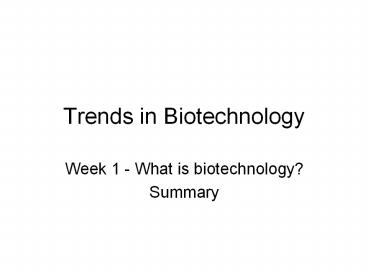Trends in Biotechnology - PowerPoint PPT Presentation
Title:
Trends in Biotechnology
Description:
Trends in Biotechnology Week 1 - What is biotechnology? Summary 4. Now, many chemicals are produced: a) Amino acids. b) Pharmaceutical compounds such as antibiotics. – PowerPoint PPT presentation
Number of Views:259
Avg rating:3.0/5.0
Title: Trends in Biotechnology
1
Trends in Biotechnology
- Week 1 - What is biotechnology?
- Summary
2
- Biotechnology
- uses living organisms or substances from those
organisms, to - make or modify a product,
- improve plants or animals,
- develop microorganisms for specific uses.
3
(No Transcript)
4
- Many things in organisms are affected by genes.
5
- Biotechnology is multidisciplinary, covering many
areas.
6
- There are many applications of biotechnology.
7
- In the past people used living organisms without
really understanding why things happened. - Eg selective breeding of plants and animals
8
- Fermentation was widely used to make bread,
kimchi, winie, beer, yoghurt, cheese, makgeolli,
and soy sauce. - It is a microbial process which enzymatically
changes organic compounds. - Fermentation was used for years without knowing
the processes.
9
- In 1680, Anton van Leeuwenhoek looked at samples
of fermenting yeast under a microscope. - Between 1866 and 1876, Pasteur finally showed
that yeast and other microbes were responsible
for fermentation.
10
- Classical and modern biotechnology has improved
fermentation. Many new and important compounds
can be produced. - The amount of fermentation products increased
greatly from 1900 to 1940.
11
- Industrial fermentation was developed to make
glycerol, acetone, butanol, lactic acid, citric
acid, and yeast biomass. - Aseptic (???) techniques improved industrial
fermentation by the 1940s, as well as the control
of nutrients, aeration, methods of sterility, and
product purification. - The modern fermenter, also called a bioreactor,
was developed to mass-produce antibiotics such as
penicillin and others.
12
- 4. Now, many chemicals are produced
- a) Amino acids.
- b) Pharmaceutical compounds such as
antibiotics. - Many chemicals, hormones, and pigments.
- Enzymes with a large variety of uses.
- e) Biomass for commercial and animal
consumption (such as single-cell protein).
13
- Biotechnology
- uses living organisms or substances from those
organisms, to - make or modify a product,
- improve plants or animals,
- develop microorganisms for specific uses.
14
- Biotechnology
- uses living organisms or substances from those
organisms, to - make or modify a product,
- improve plants or animals,
- develop microorganisms for specific uses.
15
(No Transcript)
16
(No Transcript)
17
- Many things in organisms are affected by genes.
18
- Many things in organisms are affected by genes.
19
- Biotechnology is multidisciplinary, covering many
areas.
20
- Biotechnology is multidisciplinary, covering many
areas.
21
- There are many applications of biotechnology. Is
is used in multiple ways.
22
- There are many applications of biotechnology.
23
- In the past people used living organisms without
really understanding why things happened. - Eg selective breeding of plants and animals
24
- In the past people used living organisms without
really understanding why things happened. - Eg selective breeding of plants and animals
25
- Fermentation was widely used to make bread,
kimchi, winie, beer, yoghurt, cheese, makgeolli,
and soy sauce. - It is a microbial process which enzymatically
changes organic compounds. - Fermentation was used for years without knowing
the processes.
26
- Fermentation was widely used to make bread,
kimchi, winie, beer, yoghurt, cheese, makgeolli,
and soy sauce. - It is a microbial process which enzymatically
changes organic compounds. - Fermentation was used for years without knowing
the processes.
27
- In 1680, Anton van Leeuwenhoek looked at samples
of fermenting yeast under a microscope. - Between 1866 and 1876, Pasteur finally showed
that yeast and other microbes were responsible
for fermentation.
28
- In 1680, Anton van Leeuwenhoek looked at samples
of fermenting yeast under a microscope. - Between 1866 and 1876, Pasteur finally showed
that yeast and other microbes were responsible
for fermentation.
29
- Classical and modern biotechnology has improved
fermentation. Many new and important compounds
can be produced. - The amount of fermentation products increased
greatly from 1900 to 1940.
30
- Classical and modern biotechnology has improved
fermentation. Many new and important compounds
can be produced. - The amount of fermentation products increased
greatly from 1900 to 1940.
31
- Industrial fermentation was developed to make
glycerol, acetone, butanol, lactic acid, citric
acid, and yeast biomass. - Aseptic (???) techniques improved industrial
fermentation by the 1940s, as well as the control
of nutrients, aeration, methods of sterility, and
product purification. - The modern fermenter, also called a bioreactor,
was developed to mass-produce antibiotics such as
penicillin and others.
32
- Industrial fermentation was developed to make
glycerol, acetone, butanol, lactic acid, citric
acid, and yeast biomass. - Aseptic (???) techniques improved industrial
fermentation by the 1940s, as well as the control
of nutrients, aeration, methods of sterility, and
product purification. - The modern fermenter, also called a bioreactor,
was developed to mass-produce antibiotics such as
penicillin and others.
33
- 4. Now, many chemicals are produced
- a) Amino acids.
- b) Pharmaceutical compounds such as
antibiotics. - Many chemicals, hormones, and pigments.
- Enzymes with a large variety of uses.
- e) Biomass for commercial and animal
consumption (such as single-cell protein).
34
- 4. Now, many chemicals are produced
- a) Amino acids.
- b) Pharmaceutical compounds such as
antibiotics. - Many chemicals, hormones, and pigments.
- Enzymes with a large variety of uses.
- e) Biomass for commercial and animal
consumption (such as single-cell protein).

